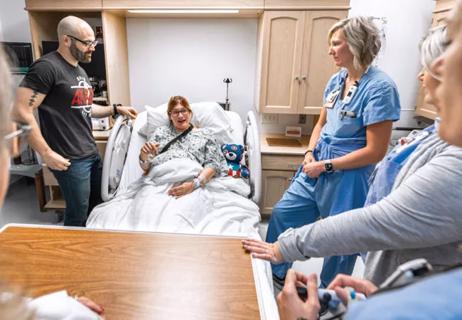Program promotes vaginal delivery for low-risk patients

In 2013, cesarean deliveries accounted for 29 percent of the 4,472 births at Hillcrest Hospital, a regional hospital in the Cleveland Clinic healthcare system. Physicians and nurses in the Family Maternity Center were dissatisfied with such a high number, so they instituted a quality improvement project to lower the primary cesarean delivery rate. Elliot Phillipson, MD, who was Director of Obstetrics & Gynecology at Hillcrest Hospital at the time, spearheaded the initiative. At the center of the project was in-service education called “Thursdays in August.”
Cleveland Clinic is a non-profit academic medical center. Advertising on our site helps support our mission. We do not endorse non-Cleveland Clinic products or services. Policy
While cesarean section can save lives when vaginal delivery poses risks for the mother or baby, it is often performed when medically unnecessary. This, in turn, puts mothers and babies at risk for health problems.
“Cesarean section is one of the most common major surgeries in the world,” says Karen Prescott, MSN, RN, CNOR, Obstetrics Clinical Nurse Educator at Hillcrest Hospital. “However, maternal and neonate morbidities increase with cesarean deliveries. In addition, cesarean section rates are reported publically and highly scrutinized, which can affect reimbursement.”
Two years ago, the Family Maternity Center at Hillcrest began a collaborative effort to reduce primary cesarean deliveries among low-risk, full-term, singleton, primiparous women of vertex presentation. The program includes in-service education and caretaker huddles when cesarean deliveries are being considered.
Every Thursday in August, Prescott and Sudhakar Rao, MD , who replaced Dr. Phillipson as Director of Obstetrics & Gynecology at Hillcrest Hospital in February, team with other providers to conduct one-hour sessions for physicians, certified nurse midwives and nurses covering indications for primary cesarean deliveries and strategies for promoting vaginal deliveries. Topics reviewed include:
Much of the session is spent discussing ways to decrease the primary cesarean rate. This includes allowing more time for the progression of labor, increasing the time for the latent phase of labor, allowing more time for rotation and descent of the baby and performing operative vaginal delivery when appropriate.
In addition to in-service education, the Family Maternity Center developed a patient chart review for low-risk patients and implemented huddles for patients prior to cesarean deliveries. The chart review includes basic information on the patient, such as maternal age, gestational age and maternal BMI. It logs the reasons why a patient is slated for cesarean, with details on failure to progress, arrest of labor and nonreassuring fetal heart rate monitoring. For example, the section on failure to progress includes questions about the use of intrauterine pressure catheters and Pitocin®.
When caregivers decide a patient needs a cesarean delivery, the team gathers to review the patient’s chart. Then they discuss options that might help the patient delivery vaginally: Could the patient change positions? Were interventions employed for decreased variability? Did the team consider a vacuum or forceps delivery?
Hillcrest Hospital’s “Thursdays in August” program, which is mandatory for all hospital labor and delivery nurses, is working. Last year, the percentage of cesarean deliveries for low-risk, full-term, singleton, primiparous women of vertex presentation was 24.8 percent. The Family Maternity Center’s goal is 23.5 percent, which it met in March 2015 and exceeded in April (21.1 percent).
“All of our efforts – the education, chart review and huddles – are designed to make things better for patients,” says Prescott. “Then you can go into the operating room knowing you did everything you possibly could for the patient.”

Nurses play pivotal role in patients’ ability to recover in the comfort of their own homes

Advocating for patient safety is imperative in fast-paced surgical settings

Advice for those pursuing a WOC nursing career

Redesigned protocols enhance infection-prevention measures

Longevity in healthcare, personal experiences may provide caregivers with false sense of confidence

Specialized team prioritizes trauma-informed care and evidence collection

Collaborative approach leans on expertise of nurses

TeamBirth aims to improve outcomes by facilitating collaboration between patients and caregivers